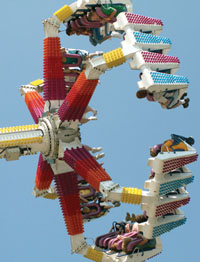Module 5—Circular Motion
 Reflect and Connect
Reflect and Connect

© Lim Yong Hian/shutterstock
What makes vertically circular rides so much fun? On a Ferris wheel, for example, the riders at the top experience an inward force that is due to gravity while the tension in the steel opposes it (but not completely). This gives you the sensation that your apparent weight is dropping, since the tension acting on you is less than the force of gravity, which makes you feel light as you travel downward along the arc. On a roller coaster, at just the right speed, the tension in the steel is zero at the top, allowing the riders to free fall and experience weightlessness as they descend. At greater speeds, the tension can act inward, pulling the rider into the seat and accelerating them downward at a rate greater than that of gravity alone. What you experience on the ride is directly related to the amount of tension acting on you as the ride moves.
At the bottom of a roller coaster or Ferris wheel, the inward force is directed upwards and caused by the tension in the steel. At this point, the force of gravity opposes the inward tension. Since it is the tension at the bottom that you feel, it has to be greater than that of gravity in order to keep the riders on a circular path. As a result, the riders experience acceleration larger than gravity, making them feel heavy. At higher speeds, the tension is greater and so, too, is the heavy sensation. At higher speeds, in general, all the forces are larger, which makes the use of seat belts a common safety feature on high-speed rides, such as roller coasters, but not on low-speed rides, such as Ferris wheels.


© Lori Sparkia/shutterstock
 Discuss
Discuss
Some thrill rides offer both horizontal and vertical motion at different points in the ride. In the discussion forum, explain the change in sensation that the people in the rides pictured here experience as they move from a horizontal position to a vertical position.
 Reflect on the Big Picture
Reflect on the Big Picture
Each of the Reflect on the Big Picture sections in this module will ask you to consider the movement of objects in a circle or part of a circle. Complete at least one of these reflection activities:
- Create a drawing, painting, or multimedia presentation that describes the sensations of roaring through a loop on a roller coaster.
- Research the effects of apparent increases and decreases of gravity on the human body. Look for ways to prepare for the sensations you experience on carnival rides.
Store your completed reflection in your Physics 20 course folder.
 Going Beyond
Going Beyond

How is vertical circular motion explained at positions that are not at the top or bottom of the circular path? Consider the free-body diagram here. A coordinate axis (dashed lines) is introduced to define the directions. Notice that the weight is not on the same axis as the tension; therefore, the magnitude of the inward force cannot be found by simply adding the magnitude of the weight and tension.

To determine the inward force, you must first resolve the weight into a component that acts in the same direction as the tension force and a component that acts at right angles to it. The component of weight, labelled W1, acts parallel to the tension (towards the centre of the circle). Therefore, the inward force can be found by adding the tension and parallel weight component. For example,
![]()
Can you show that the expression for the tension, in this case, is given by the equation ![]() ?
?
Do the special cases of θ = 270° and θ = 90° give expressions that are equivalent to the equations derived for the top and the bottom of the vertical circle?
If the ball rotates 270° counterclockwise from the positive x-axis, the ball will be at the bottom of the circle and sin (270°) = −1. Therefore, the equation becomes

If the ball rotates 90° counterclockwise from the positive x-axis, the ball will be at the top of the circle and sin (90°) = +1. Therefore, the equation becomes
![]()
 Module 5: Lesson 2 Assignment
Module 5: Lesson 2 Assignment
Remember to submit the Module 5: Lesson 2 Assignment to your teacher.